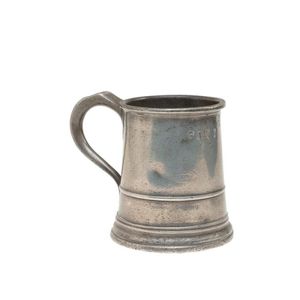Georgian silver tankard with glass bottom
You must be a subscriber, and be logged in to view price and dealer details.
Subscribe Now to view actual auction price for this item
When you subscribe, you have the option of setting the currency in which to display prices to $Au, $US, $NZ or Stg.
- Georgian - As an English stylistic period, Georgian is usually taken to cover the period from George I (1714) to the Regency of Prince George (1811-20), although the period from 1800 to 1830 is sometimes designated as the Regency period. During the Georgian period the great English cabinetmakers and designers such as Chippendale, Hepplewhite, Adam Sheraton etc., were all active.
Therefore there isn't a single 'Georgian style' as such and to say something is 'Georgian', usually means it was made between 1714 and 1830. This assumes we discount George V and George VI, both being from the 20th century.
The styles popular at the time of each reign were:
George I (1714-1727) saw out the last years of the Baroque period.
George II (1727-1760) reigned during the Rococo period.
George III (1760-1820) saw the last gasp of the Rococo, all of the early Neo-Classic 'Adam style' and most of the later neo-Classic 'Regency style'.
George IV (Prince Regent 1820-1830)encompassed the last of the 'Regency' style.
William IV's reign (1830-1837) was something of a no man's land (stylistically) and he wasn't a 'George' anyway. He covered the last glimmerings of 'Regency' and the start of the 'Victorian' style. - Sterling Silver - Sterling silver is a mixture of 92.5% pure silver and 7.5% of another metal, usually copper. Fine silver is 99.9% pure silver, and is relatively soft and the addition of the very small amount of copper gives the metal enough strength and hardness to be worked into jewellery, decorative and household objects.
- Tankard - A tankard is a drinking vessel for beer, ale, and cider, similar in shape to a large mug, and usually with a hinged lid. Silver tankards were in use in Britain and other parts of Europe from at least the sixteenth century, pewter tankards probably from the thirteenth. In the 19th century a number of ornately carved ivory tankards were produced, but these were designed to demonstrate the skill of the carver, rather than for day to day use. The shapes of tankards vary, sometimes globular, sometimes a tapering concave. For those with lids, the lid usually includes a thumbpiece that the drinker can hold down to keep the lid open. Variation in the design of the thumbpiece include wedge, ball and wedge, ball, hammer head, bud and wedge, double volute (scroll), chair-back, ball and bar, shell, double acorn, corkscrew, and ram's horn.
This item has been included into following indexes:
Visually similar items

An Edward VII small silver mug, plain form with inscription to front C.E.Mc.C; Samuel Hardy, London, 1904. Height 7 cm. Weight 151.2g.

Antique Australian silver Wendt christening mug, engraved with initials and date 1st Sept 1876, with silver and makers marks - JMW (for Jochim Matthias Wendt of Adelaide), 9.5 cm high approx. 155 grams

A Georgian pewter mug, stamped 'Pint' and initials 'C.S/NA', 11 cm high

A Victorian sterling silver christening mug by Barnard Brothers, London 1846, 9 cm high
